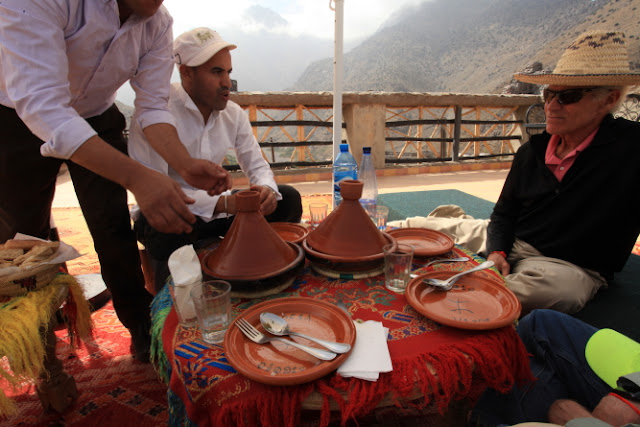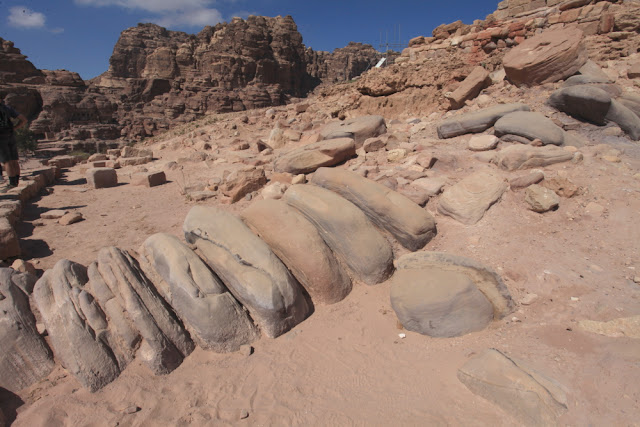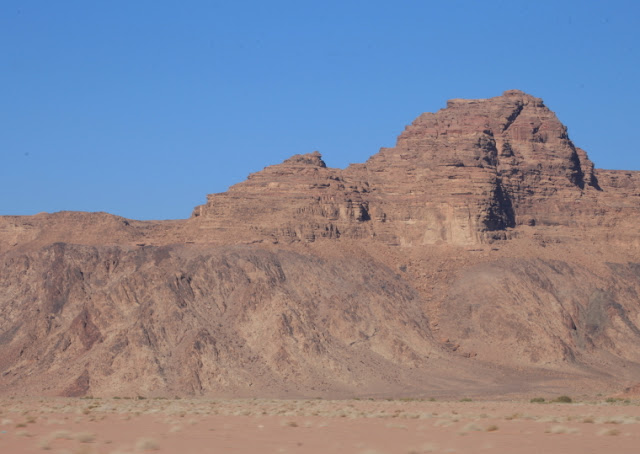But they are not far away and after traveling south a short distance (20 miles) sedimentary rocks are seen that have been uplifted into foothill terrain.
When the vehicle stoped at the end of the road, we embarked on a hike. In this tiny village were huge boulders that had come off the mountain front. Later on the hike, I would recognize their interesting origin.
We took one lane roads to the village (at about 5000 feet above sea level) and then hopped on the trail. This is where our 45 minute trek up to another small village began.
Along the way we saw walnut trees that have been plucked for the bark which is used to clean teeth. The scars from this activity were seen on many trees.
Rocks with large plagioclase crystals were evident. Note the area left of the lens cap with the many holes in it. This may be a vesicular volcanic rock that was erupted out with the plagioclase laths. These rocks are Precambrian in age and so many of the original volcanic textures are gone.
Looking at back at the village where we started the trek.
Villages up another side valley in the side of the mountains.
Approaching the destination, we see more huge boulders lying on the slope. What could they be?
This is the highest peak in this part of the High Atlas, Mt. Tabkoul at an elevation of 13,671 feet. There are many trails in this part of the mountains and we saw many trekkers from Europe who were backpacking on multi-night trips.
We were welcomed to the village called Aremd, by the "mayor" and a woman who was making traditional bread.
She pats out the dough into flat layers and then cooks on the metal pan above a mud oven The bread was delicious!
A musical serenade for our little group.
The "mayor" then performed the tea ritual, which was quite elaborate and took over 20 minutes with many pourings in and out of the cups of mint leaves.
One of the pours of tea being made.
Many Moroccan meals are prepared in the tajin. Here we had a vegetable and a chicken tajin for lunch.
While looking up to the mountains, I saw where the huge boulders might be coming from. The background slope in the far distance on the upper right was composed of lighter-colored rocks. However at the base of this slop[e was a darker pile of huge boulders that had a concordant surface with the same looking material behind the buildings and the top of the two poplar trees. It appeared to me that part of the upper mountain had broken away and came to rest at the foot of the mountain as a huge pile boulders. The stream has since dissected through the deposit after it was emplaced. Thus, the position of Aremd on a relatively flat surface was wholly due to catastrophic slope failure from the above. Some of the boulders have been dislodged again coming to rest in the lower village. I had our interpreter explain what I was seeing to the "mayor"but I think he was stymied at the part where I said 'a long time ago.'Amazing geology!
A picture might help. The dashed blue line on the right is the boundary between the light-colored bedrock and the loose boulder deposit. The orange line shows the top of the debris field (dashed where the deposit is scoured out by the stream). The boulders originated within another rock unit higher up on the mountain to the right and splayed out into the valley.
The village has an aspect of the Medieval and electricity has only been here for about 30 years.
It was apple harvest season and everywhere we looked we saw apple groves, people picking apples, gathering and packing apples, selling apples, giving us apples.
Rugs and flowers in Aremd.
This rock looked like rhyolite, more evidence of ancient volcanism.
Local nuts in a tajin-looking basket.
Fragrances everywhere is what I will remember of Morocco - and the stunning landscape.
This concludes my journey Around the World. 32,000 miles in.the private jet (37,000 miles for me living in western North America). It was the trip of a lifetime but I get to do another one next April on a totally different itinerary. Thank you reading!




















































